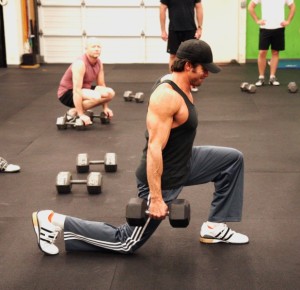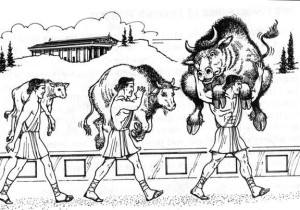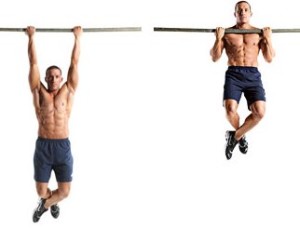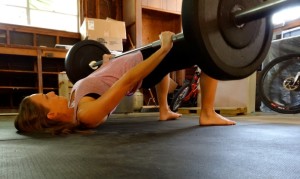In this article, I’m going to teach you how to go about progressive overload – the most important law in strength training. Perhaps you’re new to lifting and you’re wondering exactly what progressive overload is. Well, progressive overload simply means that you’re doing more over time. For example, you could be adding some weight to the bar, doing more reps, and/or having more productive training sessions. You won’t find many comprehensive articles on this topic as it’s pretty difficult to write an all-encompassing article pertaining to progressive overload. Due to the large variance in the fitness abilities of people when they first embark on a training regimen, it’s a little more complicated than simply telling someone to “add 10 more pounds to the bar each week,” or “do 2 more reps with the same weight each week.”
Unfortunately, I can’t give you a precise prescription. In order for me to know exactly how you should progress, I have to be with you, watching you train. Since I can’t be there with you, I’ll give you some advice to adhere to, which should make your life easier. Here are the ten rules of progressive overload:
1. Progressive Overload starts with whatever you can do with perfect technical form
Let’s say you’re brand new to a particular exercise. You’ve seen all sorts of Youtube videos of strong lifters hoisting hundreds of pounds. You think you’re a strong cat, so you load up the plates and find that the exercise just doesn’t feel right. It feels awkward, unnatural, you don’t feel the right muscles working, and it even seems jarring on the joints and potentially injurious. This exercise is definitely not right for you, right? Wrong! The exercise is probably right for you, but your approach was all wrong.
Do not concern yourself with what others use for loading. When you begin an exercise, start out as light as possible and gradually work your way up. Let me provide you with two examples – the starting point for the weakest non-elderly and non-injured beginner I’ve trained as well as the starting point for the strongest beginner I’ve trained. Chances are you’ll fall somewhere in between these two individuals.
The weakest beginner I ever trained (a middle-age woman who had been completely sedentary for around 15-years) had to start out with bodyweight high box squats on the adjustable step-up platform so that she was only descending around 8 inches before sitting on the box. This same client also performed glute bridges, step-ups from a 4” step, and hip-hinge drills – all done with just bodyweight.
But guess what? She was squatting, hip thrusting, step-upping, and deadlifting. Granted, she was performing the most remedial variations of those exercises, but this is what was right for her at the time. Within six months she was doing goblet full squats, barbell hip thrusts, Bulgarian split squats, and deadlifts from the floor with 95 lbs.
Conversely, the strongest beginner (a high-school wrestler) I ever trained was able to use 185 lbs for full squats, 225 lbs for deadlifts, 225 lbs for hip thrusts, 155 lbs for bench press, and could do Bulgarian split squats, single leg hip thrusts, and chin ups with great form. Though he was an athlete, surprisingly he had never lifted weights before. Sports had strengthened his legs and upper body so that he was able to start out at a much more advanced level than most beginners. Even my (at the time) 13-year old niece, a very good volleyball player, full squatted 95 lbs, trap bar deadlifted 135 lbs, and single leg hip thrusted (all with excellent form) in her very first weight training session.
But these people are not you. You’ll find that due to your unique body type, you’ll have an advantage with some exercises and a huge disadvantage with others. Long femurs? You probably won’t set any squat records, but your weighted back extension strength is going to kick some serious butt. Long arms? Kiss your bench press records goodbye, but you’re gonna be a deadlifting rockstar.
Figure out where you belong on the regression-progression continuum (this is basically a list of each variation of an exercise from the easiest possible version to the most challenging version) and start getting stronger.
2. Progressive Overload for beginners involves a few tenets
Progressive overload methodology is different for beginners compared to more advanced lifters. It’s also different for men compared to women and for those carrying a lot of muscle versus those not carrying much muscle. For example, I can’t just tell a woman who is brand new to strength training to just add ten pounds to the bar for squats and deadlifts each week. First of all, chances are some work has to be done just to get her to squat and deadlift properly, before ever focusing on load. Some clients should start out with partial range lifts such as bodyweight box squats and rack pulls and simply work on “progressive distance training,” whereby the range of motion is slightly increased each week. If you keep squatting your own bodyweight (or rack pulling 65lbs) for 3 sets of 10, but each week you descend an inch deeper, that’s progressive overload. Eventually you’ll be using a full range of motion and can then concern yourself with adding load.
With exercises that have you moving a significant portion of your body, such as squats, hip thrusts, back extensions, and lunges, you must master your own bodyweight before adding load. I like my clients to be able to perform 3 sets of 20 full-ROM reps with bodyweight exercises before adding load.
Furthermore, many lifts require very small jumps in load over time, and attempts in these particular exercises should usually involve jumps in repetitions instead of load. This applies to lifts that utilize smaller loads, for example curls and lateral raises, in addition to challenging bodyweight movements such as skater squats, single leg RDLs, single leg hip thrusts, and prisoner single leg back extensions.
This is especially important for women or smaller men when access to smaller plates (1.25lb or 2.5lb plates) or smaller jumps in dumbbell (ex: 17.5lbs) or kettlebell loads aren’t possible. Think about it – going from 50 to 55 lb dumbbells is a 10% jump in weight. However, going from 10 to 15 lb dumbbells is a 50% jump in weight. You cannot expect someone to make a 50% jump in load and execute the same number of repetitions as the week before, but you can expect them to get another rep or two with the same load. So let’s say that one week you perform dumbbell rear delt raises with 10lbs for 10 reps. The next week, rather than up the load to 15lbs, try performing 12 reps with the 10lb weights. When you get to a point where you can do a couple of sets of 20 reps, then jump the weight up to 15 lbs.
3. Progressive Overload can be achieved in a variety of ways (12 primary ways I can think of)
Remember, progressive overload is simply “doing more over time.” There are many ways to go about this. In this article, I’ve already mentioned progressing in range of motion, repetitions, and load. In the beginning, you want to progress in range of motion and form. Yes, if you do the same workout you did the week before, but with better form, that’s progression. You “did more” for the neuromuscular system in terms of motor patterning and even muscle force since using better form involves relying more on the targeted muscles.
After proper form and full range of motion are established and ingrained, now it’s time to worry about progressing in repetitions and load. But these aren’t the only ways to progress. Here are all the practical ways I can think of:
- Lifting the same load for increased distance (range of motion)
- Lifting the same load and volume with better form, more control, and less effort (efficiency)
- Lifting the same load for more reps (volume)
- Lifting heavier loads (intensity of load)
- Lifting the same load and volume with less rest time in between sets (density)
- Lifting a load with more speed and acceleration (intensity of effort)
- Doing more work in the same amount of time (density)
- Doing the same work in less amount of time (density)
- Doing more sets with the same load and reps (volume)
- Lifting the same load and volume more often throughout the week (frequency)
- Doing the same work while losing body mass (increased relative volume)
- Lifting the same load and volume and then extending the set past technical failure with forced reps, negatives, drop sets, static holds, rest pause, partial reps, or post-exhaustion (intensity of effort)
Just remember, improvements in form and ROM come first, and increases in reps and load come second.
4. Progressive Overload will never be linear
Many strength coaches love to tell the story about Milo of Croton to illuminate the merits of progressive overload. Legend has it that Milo used to pick up a baby calf every day and carry it around on his shoulders. As the calf grew, Milo got stronger. Eventually Milo was hoisting a full-size bull and busting out sets of yoke walks like it ain’t no thang. Pretty sweet story, right?
Unfortunately this story is a crock of bull (pun intended). First of all, a half-ton bull would be way too awkward to carry due to the lopsided nature and sheer size of the animal. But this is irrelevant.
No gains from weight training, be it mobility, hypertrophy, strength, power, endurance, or fat loss, will ever occur in a linear nature. The body doesn’t work that way. Adaptations happen in waves. Sometimes you’ll make big jumps in a single week in a particular quality, while other times you’ll stall for three months in another quality. Over the long haul, everything goes up, but it’s a windy road. There are physiological reasons for this phenomenon, which is beyond the scope of this article.
However, let’s pretend for a minute that you could make linear progress for an entire year on a particular lift. A 10lb jump per week equates to 520lbs in a year. Even a 5lb jump per week equates to 260lbs in a year. Moreover, a 1 rep jump per week equates to 52 reps in a year, while a 1 rep jump per month equates to 12 reps in a year. You won’t gain 260-520lbs in a year on any single lift. And you won’t gain 12-52 reps on most lifts either. It just ain’t happening. Some sessions you’ll be surprisingly strong and make big gains, some sessions you’ll simply tie your previous efforts, and some sessions you’ll actually be weaker and go backwards. But every six months you’ll likely be stronger and fitter.
These charts depict a woman’s progress over a one-year period in bodyfat percentage and lean body mass in kilograms. She made the most dramatic transformation I’ve ever seen to date, but notice the non-linear adaptations. Also notice the drop in muscle, despite doing everything right. This woman gained a ton of strength on squats, deadlifts, hip thrusts, bench press, military press, rows, and chins, she never missed a training session, and she ate perfectly for an entire year, yet she lost around 11 lbs of muscle during her year-long pursuit of getting into contest shape of below 10% bodyfat. Nevertheless, she won her first figure competition and is now a popular figure competitor.
5. Progressive Overload will never be as fun as it is during your first 3 months of lifting
If you’re a beginner, sit back and enjoy the ride! Your rate of strength gain during your first three months of proper weight training will be higher than at any other time in your life. Each week you will slaughter personal records. Getting fifteen reps with something that you got for only ten reps the previous week is not an uncommon occurrence. This is mostly due to rapid gains in intermuscular coordination. Just don’t get spoiled, your rate of gain will slow dramatically and pretty soon you’ll be just like the rest of us – fighting like hell for those PR’s.
6. Progressive Overload for veteran lifters requires serious strategy and specialization
As a beginner, you can pretty much do anything and gain strength as long as you’re consistent. After a couple of years of solid training, however, you have to be clever about your programming in order to continue to reach new levels of strength. You’ll need to rotate your lifts, plan your program designs intelligently, fluctuate your training stress, and tinker around with methodologies. Eventually it becomes very difficult to pack more pounds onto a particular lift or even gain another rep.
7. Progressive Overload is much harder when you’re losing weight
Unless you’re a beginner, it’s highly challenging to increase your strength while simultaneously dropping significant weight. In fact, simply maintaining your strength while losing weight is a form of progressive overload as you’d be increasing your relative strength (strength divided by bodyweight) and therefore “doing more over time.”
Some lifts are more affected by weight loss than others. Squats and bench press tend to take a big dive, whereas deadlits can sometimes stay put. Your strength endurance on bodyweight exercises for the upper body will see a huge jump when you lose weight, however, so enjoy the boosts in reps on push-ups, chins, dips, and inverted rows.
8. Progressive Overload sometimes has a mind of its own
Quite often you’ll do everything right, but you won’t get stronger. The plan just won’t work. You’ll be lifting hard, adhering to an intelligent plan, eating well, and sleeping right, and yet you still you won’t set any PR’s. Other times, you’ll do everything wrong, and you’ll somehow gain strength. Your training can be derailed, your diet and sleep can go down the gutter, but you’ll go to the gym and set a PR. This makes absolutely no sense and flies in the face of sports science. Nevertheless, this is just how the body works sometimes. Physiology is tricky and multifactorial. Don’t get cocky when this happens and think that you’ve stumbled upon the secret system (excessive partying, eating junk food, and training sporadically). Whenever you engage in these behaviors for too long, it will backfire on you, so stay on track to the best of your abilities.
9. Progressive Overload should never be prioritized over proper form
At any point in time, if you really want to set a PR, you can just be lax on your form and likely set a record. For example, you could round your back excessively during deadlifts, bounce the bar off your chest with bench press, or use a little more body English with curls. However, this is a slippery slope that’s best avoided. Progressive overload only works when you challenge the muscles to do more over time, and your muscles will not be forced to do more if your form gets sloppy. Moreover, you won’t be setting any personal records if you’re injured or constantly in pain.
10. Progressive Overload requires standardized technique
The only way you will ever know whether you gained strength or not is to perform the lifts exactly the same way each time. In other words, true strength gains require proper depth, tempo, and execution. Many lifters lie to themselves and pretend that they’ve gotten stronger, but their ranges of motions diminish or their form goes out the window. These lifters didn’t get stronger, they got sloppier. Federations in the sports of powerlifting, Olympic weightlifting, and strongman have created rules for their various exercises. It may be worth your while to learn these rules so that you always perform them properly in training and when testing your max. Assuming you can perform the lifts properly, always squat to parallel or deeper, always lock out your hip thrusts and barbell glute bridges, and in general always control the weight through a full range of motion.
Hopefully these 10 rules will keep you on track. I have one more piece of advice to share with you. Even the most seasoned lifters often have to take a step back in order to take two steps forward. Sometimes we get caught up in chasing continuous PR’s to the point of altering form, relying on the wrong muscles, skimping on ROM, or training through pain. Once per year, I recommend “resetting” your strength levels in your pursuit of progressive overload. Throw everything you’ve done in the past out the window and start over using the best possible form through a full range of motion. This is your new baseline. Now work on adhering to that same form while doing more over time. Your body will thank you in the long run for engaging in this simple yet effective practice.
To download a free pdf of this report, click on this: 10 Rules of Progressive Overload













the pdf link doesnt work!
Fixed! Try again. I just learned how to do this. Pretty cool methinks!
great resource Bret, thanks!
ignore that, its working now
One of the best articles about guidelines in progression I’ve read. They are true.
Thank you so much!
Agreed. First articel Ive seen which talks about when progression DOESNT happens.
Thanx! 🙂
Great Article,
As a season veteran of lifting(25 years) it is refreshing to re-read the basics since you can always learn something
This is awesome! One question though. When you train women who are just beginning and you have them do more reps from workout to workout, would that ten reps of 10lbs be their current “max” with good form then the progressive overload would be 10lbs for 12 reps with the same form? Also, how do you judge how hard an exercise is with women?
Thanks!!
Great articles for beginners and intermediate lifters. Big fan of your new blog Bret.
Great article Bret!
Awesome stuff, Bret. Fantastic piece.
-J
Loved this post Bret. Progressive overload is the central tenet, the principle that all other principles must step aside for. If you’re not getting stronger (as defined by these 10 rules), your training is off-track.
Great content as always Bret – and love the new lighter blog theme!
What a great start ,middle and ending to progressing in weightlifting 101. I am a beginner that jumped to the middle hoping to reach the end quicker…who now quite often goes back to the beginning to try and fix something….I have a better understanding of it all now. I am thrilled to now know I don’t have to always make gains in poundage. I knew I couldn’t but I was still always trying.. I have the type of personality traits where I always have to add something.. . .a weight increase or rep.. This trait had me walking upwards of twenty miles a day. I had to do a little more than I did the day before. I no longer walk …. but it did transfer over to the weight room in the form of volume… I do to to much sometimes…so now I have some new ways to do it differently…thanks Bret…great post …great advice…now all I need is great form….that I am working on…
love the article brett. great stuff as always. “progressive overload will never be as fun as your first 3 months of lifting.” if ony that were possible. lol. sometimes called the novice effect, I miss the days of super fast progress. Super fast progress just means you’re a beginner.
The saying that “everything works, but nothing works for very long” is certainly true. I remember my first three months of serious weight training were amazing, even though I was marching forward blindly in the dark during those days. I made the mistake of failing to manipulate any variables and failing to strive for progressive overload, thus leading to the end of my beginner’s gains. Had I been able to refer to an article like this back then, I feel like I would have been able to prevent a lot of frustrating plateaus. I’m going to e-mail a link to this article to a few people who really need it!
This is such an important and brilliantly written article. I am going for strength at the moment but have only been lifting for six months. I am making good gains doing 5 x 5 on the compound lifts but I can see this stalling as it gets just too heavy too fast, even if I only increase the minimum each week (2.5kg)… my form and ROM are great however so that is a good springboard. I’ll have to keep this article in mind when I start stalling!! Thanks so much.
THANKS BRET GREAT POST.
Bret,
Great stuff as always. Particularily the point about adding higher reps for females before progression occurs. Ive found this to be a great takeaway for dumbbell lifts.
This PDF is going in my Contreras File.
Chris
This is without a doubt the best and clearest article I’ve ever read on progressive overload. Bravo, Bret!
Aleks
I concur with all the comments above – a great article explaining what one expects to go through when gaining strength. First time I got into serious weight training I saw the plateau within that 3 month period and got quite disturbed by not making much additional progress, and actually stopped for a while, thinking “What is the point?”
The most interesting thing was the case study where the women actually lost muscle mass when on an extensive training routine trying to lose weight. Based on the graph it did not appear that she was probably reducing calories too quickly, so this is a really surprising finding. I would be curious what the physiological reason behind this is.
Very thorough, Bret! Obviously, the Milo of Croton story is more legend than fact. But I do think it has a lot of validity. Assuming Milo is extremely dedicated and doesn’t miss any days or get injured, at what point is he unable to pick up and carry the bull if he was able to do so the day before?
Bret
i want to loose two pounds, but i’m too advanced… what kind of train you recomend? high reps or low reps and high intensity?
thanks a lot
This is JUST what I needed to read…I had a “bad” squat day this week and had to take a step back and remember that the same thing happened about 5 months ago and I got past it with deloading an working my way back up. It was worth it that time and I’ll do it again. Thanks Bret!
Great article, you seem like you’ve had a lot of time to really understand what you’re talking about. I like your understanding of not expecting things to come linear. Thanks for sharing.
Nice article Bret! I agree with you on this “Form above anything else”!
Great article Bret!
Reiterates a lot of my personal thoughts regarding progressive overload. 3. is a great point and I personally experienced the greatest gains when I increased intensity in a number of areas like range of motion, effort and density. Combining a progressive increase in weight with heightened density (lowering the rest time between sets) produced tremendous results for me.
Bret I just want to thank you for writing this article. Amazing! Truly the best article on “Progressive Overload” I think that I’ve ever read. Has opened my eyes to my training and what I’m doing right and wrong. The fact that a jump in load from 10lbs to 15 lbs is a significantly larger jump than 50lbs to 55lbs was new to me but makes complete sense and is obvious. I never even knew that. I’ve been training for two years now and my progress has stalled. I am trying to get my training consistent and diet on point but I am having trouble. I think I need to take advantage of social media and use it as a source of accountability. What I do know is that this article has made my efforts a lot easier and effective from here on out. Anyway thanks for the article again!!
Brutal honesty is most important advice for beginners. I love to read about REAL LIFE weight lifting. I understand Progressive Overload concept but reading about REAL LIFE limits of this “mathematical theory” is 1000% more insightfull and actually MOTIVATING than hitting the reality unprepared and wondering “what is wrong with me”. Some people are genetically more gifted and some theories just dont translate that well into real life or not for everyone or not indefinitelly. Reading this as a beginner i approach the weights in gym with way less stress and welcome each gain as “gift” not as a “right” because i followed some theory from a muscle mag or internet forum. Reading honest evidence about the limits of human muscle growth is more motivating than expecting miracles and “linear growth” and than being dissapointed that iam not like Milo of Croton or the cover guy from muscle mag. Thanks Bret for being honest and confronting the myth of Milo (and all other myths and theories) with REAL LIFE.
This is really helpful thanks. I had a pancake butt (I’m 45) and began barbell hip thrusting 4 months ago. Now I’m thrusting 165 lbs using proper form, but I can’t do more than 3 sets of 7 or 8 and I’ve been doing 165 lbs for about a month. I didn’t realize that I am in fact still progressing bc now I can do more than 5 or 6 reps with this weight. I have been dropping the weight to 135 lbs for the fourth set doing 20 pumping reps and then just the bar doing 30 pumping reps. I hold the last rep of all my sets for as long as I can before my muscles are burning too much.
This is a reminder that my progression must entail proper form no matter what. I am also using a stepper for my shoulders with 3 bars bc I am fixing a posterior pelvic tilt and my lower back really starts to hurt when I use a bench. The lowish stepper; I am ok and can manage proper form.
Any tips for me being a newbie to this? Glutes are getting bigger btw. Very small progress though…no more than an inch.
I want to download this article but it is error, hope you will fix it. Thanks!